One is a solid episode.
Indeed, One is so solid that it is the rare episode of Star Trek: Voyager to be repurposed for Star Trek: Enterprise. The prequel series tended to borrow stock Star Trek plots, but it tended to borrow most heavily from Star Trek: The Next Generation and even Star Trek: Deep Space Nine; Oasis was Shadowplay, Vanishing Point was Realm of Fear, Dawn was Darmok. However, One would be reworked as Doctor’s Orders, another pseudo-horror bottle episode in which a member of the cast finds themselves driven insane by isolation.

Everything’s gone askew…
However, One has an in-built advantage over Doctor’s Orders, in that it is centred on a character who practically begs for this sort of treatment. Seven of Nine is effectively a reformed Borg drone. While Jean-Luc Picard was assimilated in The Best of Both Worlds, Part I and recovered in The Best of Both Worlds, Part II, and while Chakotay brushed up against a pseudo-collective in Unity, Seven of Nine is the first franchise regular to have spent the bulk of her life inside the Borg Collective. The nature of the Borg means that Seven is perfectly suited to a story about isolation.
One is a messy and clumsy episode in a number of ways, particularly in its drive for big action set pieces and tangible threats. In particular, the penultimate act of One feels awkward, as if the production team do not trust the audience to engage with a purer breed of psychological thriller. However, One leans very heavily on the character of Seven of Nine and on the performance of Jeri Ryan. Luckily, both character and actor are up to the task.

Voices in her head.
One was pitched by writer James Swallow. At the time, Swallow was working as a journalist covering the franchise for Star Trek: Monthly. Reportedly, he came to the attention of the production staff for asking questions about the mechanics of plotting and pacing episodes in interviews for the magazine. As Swallow explains, he was asked to pitch off the back of those interviews:
Eventually, I got to know a few members of the team, including Lolita Fatjo, who was working as a script coordinator for the show. She basically said, “Clearly you want to do this for a living, would you like to come in and pitch a few story ideas?” And, absolutely yes! It was almost like she held the door open, kind of looked the other way and let me sneak in.
And I started pitching for Voyager, which was a hellish, hellish experience! It’s just not fun at all. It’s like being on The X-Factor, you know, you come out and you sing your heart out and in ten seconds someone goes, “No, that’s terrible, off you go.” It doesn’t matter how hard you worked or how much you put behind it, if you don’t hit the right note, then you’re out the door. I think I must have pitched something like three or four hundred story ideas in the course of all the years that I was pitching for Star Trek.
To be fair to Swallow, he did pitch two successful ideas. He was also responsible for the pitch that became Memorial during the sixth season of Voyager. Even if that had not been the case, Swallow still pitched a story idea that was so compelling that it would be recycled for another Star Trek series a little over a half-a-decade later.

Warped perspective.
Swallow’s success pitching for Voyager would become a stepping stone to other creative writing. Swallow has become a full-time creative writer, moving away from journalism and press coverage. He has written for a die variety of mediums covering a wide variety of subject matter. He developed his own series of novels with The Sundowners and The Rubicon. He has also scripted audiobooks for Doctor Who and 24, not to mention tie-in novels for Stargate and Warhammer 40,000.
He has also remained a staple of the Star Trek tie-in industry, particularly in the efforts to build an expanded tie-in universe set in the wake of Star Trek: Nemesis. He wrote two novels (Synthesis and Sight Unseen) focusing on the adventures of Captain William T. Riker of the USS Titan. He also wrote The Poisoned Chalice as part of the four-part series The Fall. Like David Mack before him, Swallow is a writer who pitched for Voyager and went on to have considerable influence in the development of the shared universe through novelisations.
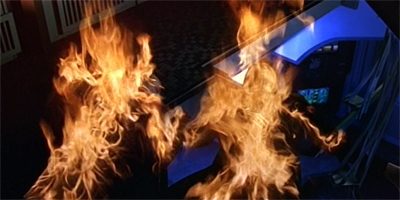
Seven’s ambitions go up in flames…
As such, the sale of One was a pretty big deal for Swallow, although he acknowledges that he was not initially sure how he should react to the news:
I could remember when I got the first story sold, which was for “One.” Lolita called me up and she said, “I wanted to be the one to call you to tell you this, you sold your story idea!” And I can remember, I had thought to myself, “If I ever sell a story I’ll be so excited and I’ll dance around the room,” and you know, and that’s not at all what happened. When she called me, I was just numb, I was like, “Oh, that’s great, yeah, brilliant…” I just had no reaction to it whatsoever, and it only kind of hours later that I suddenly thought, “Oh my god, I’ve just done this really cool thing!”
Although One was shepherded to the screen by other members of the Voyager production team, it is still a great story idea and Swallow deserves a lot of credit for that.
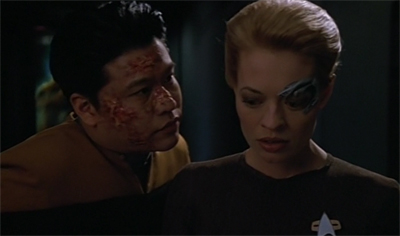
Radiating confidence.
That said, the story reportedly changed a great deal in that journey from original story idea to finished script. This makes a great deal of sense, given how the in-house writing staff tend to rework and reinvent these ideas to make them workable in the context of the series. René Echevarria has acknowledged that the version of his episode The Offspring that made it to screen was largely the work of Michael Piller and Melinda Snodgrass, while also taking credit for similarly guiding Michael Taylor’s pitch for The Visitor through the production process.
One was effectively championed by several key members of the Voyager production team. The original pitch was reportedly quite divisive and controversial among the writing staff, but it was supported by young writer Bryan Fuller and future showrunner Brannon Braga. More than that, the actual script itself was written by Jeri Taylor. It would be the last script that Taylor would write as showrunner, stepping aside at the end of the year to be replaced by Brannon Braga.

EM… Hh?
The pitch that eventually became this episode had the working title Perchance to Dream and primarily featured The Doctor. It was jokingly compared, by staff writer Bryan Fuller, to the horror film The Shining. Fuller was actually the person who bought the pitch.
He recalled, “Some responses [to the plot idea] were ‘Uhhh… Okay’, until I said ‘But! You can do this….! We can have scenes with creepy corridors, spooky hallucinations!'” Co-executive producer Brannon Braga was another writing staffer who instantly recognized that the story had potential.
It makes sense that the concept of the episode would appeal to Fuller and Braga, just like it makes sense that those two writers would reconfigure the story to focus on Seven of Nine.
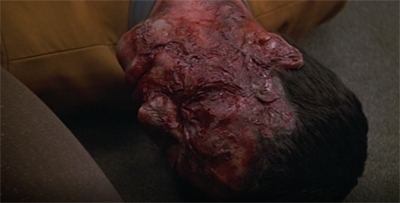
Burning up inside.
And outside.
After all, Bryan Fuller was a writer with a keen interest in the horror genre. The first two stories that Fuller had sold to Star Trek had been The Darkness and the Light and Empok Nor, both essentially futuristic twists on the classic slasher movie template. While working on Voyager, Fuller had played up the nightmarish imagery in episodes like The Raven, Mortal Coil, Retrospect and Living Witness. Those episodes all had a surreal and disturbing hallucinatory quality to them, reflecting Fuller’s own interests and sensibilities.
Fuller would remain fascinated by the trappings of the horror genre. Fuller would reboot The Munsters as Mockingbird Lane. He would bring Hannibal Lecter back to the screen in Hannibal, even going so far as to include an extended visual reference to The Shining in its opening episode. He was even attached to the reboot of the slasher film series Friday the 13th. With all of that in mind, it makes sense that Fuller would be drawn to the pitch for One.

Harry Kim will be even more sedate than usual.
Similarly, Braga was very invested in the idea of schlocky b-movie horror. Braga was the writer responsible for the introduction of the Vidiians in Phage or the giant floating viruses in Macrocosm. He was party to the psycho-sexual horror of Darkling and wrote the psychological breakdown in Projections. Braga had always been particularly invested in the weird aspects of the franchise’s science-fiction framework, the surreal and the grotesque. If One could be described as “The Shining… in space!” it makes sense that it would appeal to both Fuller and Braga.
At the same time, it makes sense that Fuller and Braga would want to rework the episode around Seven of Nine. Braga had created Seven, and so was invested in her development. Fuller had repeatedly portrayed Seven of Nine’s experiences with the Borg Collective as horrific, trauma expressing itself through the abstract imagery of The Raven and through the distorted memories of Retrospect. In some ways, One is a logical extension of that idea, exploring the psychological breakdown of a Borg separated from the Collective.

What a nebulous concept.
Of course, there is something quite revealing in the fact that One was an episode originally pitched as focusing on the EMH only to be repurposed as a story about Seven of Nine. One of the big recurring tensions in the fourth season of Voyager has been the addition of Seven of Nine to the ensemble. Jeri Ryan’s arrival generated no shortage of tension among the cast, particularly with Kate Mulgrew. While a lot of that might have been tied into Jennifer Lien’s departure, a lot of it was down to the disproportionate focus that Seven of Nine received.
Introducing a new character in the fourth season of an existing series is challenging. It is not easy to do. The character has to be developed and explored, brought up to speed with the rest of the ensemble. However, there is always the temptation to let that character hijack the show, to usurp the original cast. There are any number of horror stories about characters who invaded existing television shows like cuckoos, colonising them and reinventing them in their own image. Steve Urkel is perhaps the most obvious example, annexing Family Matters and remaking it.
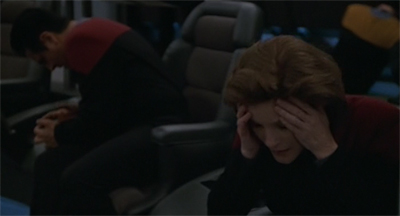
Things come to a head(ache)…
Deep Space Nine actually did a fairly decent job of introducing the two new castmembers during its run, never allowing them to steal the spotlight from the established regulars. Of course, it helps that neither character was really new. Worf was a character who had already received seven seasons of development and exploration on The Next Generation, while Ezri was merely the latest host of the Dax symbiont. Even then, there was some trace of tension among audiences who perceived these new arrivals as potential threats to the existing dynamic.
Even allowing for these difficulties in introducing a new character, the fourth season of Voyager is very clumsy in how it introduces Seven of Nine. Seven of Nine is a primary character in episodes like Scorpion, Part II, The Gift, The Raven, Prey, Retrospect, The Omega Directive, One and Hope and Fear. That is almost a third of the season. She anchors a major subplot in both Day of Honour and Revulsion. She plays a very important supporting role in the plots of Scientific Method, Mortal Coil and Hunters. That is a lot of attention for a new character in a single season.

Burn with me.
In The Fifty-Year Mission, Jeri Ryan acknowledges the tension that this created with the rest of the cast who felt like they were being squeezed out of their own show:
There is no best-case scenario. One of the problems with Seven in terms of other cast members and their characters is that you had a character who was so rich to begin with that the writers wanted to write for her. The writers would be salivating to write for anybody new after three years, so a disproportionate number of episodes had Seven as the A-storyline or a very strong B-storyline, which can be frustrating for actors who have been there for years.
And then you add on the fact that Paramount was very clear – they made no bones about it – that they saw this as their chance to break Star Trek into the mainstream media. They said that verbatim in publicity meetings before the character launch, that the sexy part of her was a way of catching attention outside of sci-fi. And they actually did it, which is why you saw a huge jump in the ratings. People who weren’t traditionally sci-fi fans who hadn’t watched before, began to watch, because you had to attract their attention. So the marketting was successful, but that was not going to be easy for the actors who have been plugging away for the previous three years. And understandably so.
Ryan has a point. Indeed, there is an interesting argument to be made that Seven of Nine effectively assimilated Voyager, radically altering the show and its dynamics to better suit her needs.
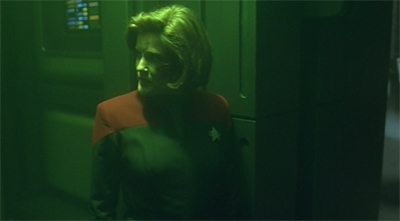
Mood lighting.
In some ways, One can be seen as an expression of these fears. This is true in a literal sense, with the episode features a number of sequences that suggest the actual assimilation of Voyager; the familiar green lighting shining in the corridors and engineering while drones stalk the corridors and the turbolift connects to the familiar Borg Collective. However, One also touches on the fear in a more indirect manner.
One imagines a version of Voyager where Seven of Nine has completely supplanted the rest of the cast, with the possible exception of a sidelined EMH. One offers up a version of Voyager where Seven of Nine is the primary focus, a character who has usurped all the functions of other cast members. Seven of Nine is effectively captain, navigator, and chief engineer. One is a version of Voyager that literalises the idea that Seven of Nine has become the most important member of the Voyager cast, playing with the notion of Seven as the only member of the crew.

Engineering a takeover of the show.
This perhaps makes it somewhat ironic that One should be the last script to be written by Jeri Taylor in her capacity as showrunner, returning to script Nothing Human early in the fifth season. Taylor had been showrunner during the third and fourth seasons, and had largely been responsible for characterising a particular version of the lead characters. The version can be seen briefly in One, with the warm conversation (and soft touch) between Chakotay and Janeway. However, Seven of Nine was very much a character created and curated by Brannon Braga, Taylor’s successor.
In some ways, One‘s focus on a version of Voyager run by Seven of Nine also taps into some classic Star Trek themes that can be traced back to the original sixties television show in much the same way that the environmental politics in Demon feel like a nineties update on the big ideas in The Immunity Syndrome. This episode is built around a part-cybernetic character defined by her commitment to “efficiency” tasked with maintaining a starship traditionally crewed by hundreds of people.

Hope you enjoy, J/C shippers, because that’s all you’re going to get for now.
This feels like a return to the anxiety around automation that informed so much of the original Star Trek show, the worry that mankind would be rendered redundant by technological advances and mechanical processes. This fear is perhaps most potently expressed in The Ultimate Computer, but it also plays through various stories about renegade robots like What Are Little Girls Made Of? or I, Mudd and crazed computers like The Return of the Archons or The Changeling. The version of this anxiety presented in One is perhaps more subtle, but it is there.
Most notably, the nebula in One affects the biological components of the ship. Most immediately, it affects the crew. In the teaser, the crew experience headaches and skin damage by mere exposure to the “subnucleonic radiation.” However, it is suggested that the mechanically processes in the ship are fine. The EMH can still function, and Seven of Nine is unaffected. It is suggested that Seven of Nine is unaffected because of her cybernetic components.
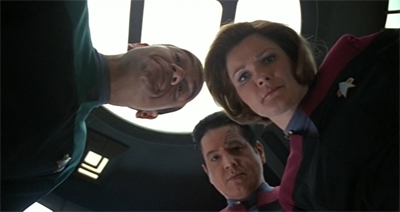
Looking down on Seven.
However, over the course of the episode, the biological processes on the ship continue to break down while the more mechanical elements function effectively. “There are malfunctions in a number of neural gel packs,” the EMH reports. “As a result, false readings were fed to the sensors which detected an emergency when there was none.” Notably, this is one of very few references to the Voyager’s biological gel packs in the later season. Even when biology and technology are fused together, One suggests that biology will fail quicker.
That is what happens to Seven of Nine herself over the course of the episode. Her implants protect her from the radiation, but her biology lets her down. She begins to hallucinate. The EMH even likens it to the corruption the gel packs. “When I studied the gel pack, I discovered the radiation was producing a degradation in the synaptic relays. I’m guessing there’s been a similar effect on your Borg implants. The radiation could be altering the neurotransmitter levels in your sensory nodes. That would explain why you’re hearing voices, seeing images.”

Seven was quite cold on the idea.
There is a fear that human flesh could never keep pace with mechanical processes, and that biology might soon be rendered redundant. It is perhaps a more nuanced expression of that classic Star Trek fear of mechanised automation, updated for the nineties. After all, American workers had long worried that jobs in manufacturing would be replaced by robots who could automate their tasks more efficient and economically. In the mid-eighties, many predicted that the major automotive companies would all operate factory floors maintained by robots, as had become popular in Japan.
The fear of mechanised automation was palpable. General Electric invested forty-two million dollars in an automated plant in Lynn, Massachusetts. Unions engaged with the challenge of updating their members’ skills to keep pace with rapidly-advancing technology. Fashion houses discovered the limitations (and explored the potential) of automated processes. There was a change in the air.

Stasis quo…
Although the worst case scenario did not materialise during the eighties, the anxiety simmered in the background into the nineties. By 1994, the United States was seeing considerable investment in robotics and automation:
In the first half of this year, 4,355 robots with a total value of $383.5 million — a record both in terms of units and dollars — were sold in the United States, according to the Robotic Industries Association in Ann Arbor, Mich., the industry’s principal trade group. That represented a 25 percent increase in value over the first half of 1993, the previous record.
And the industry’s backlog of unfilled orders stands at $350 million, the highest in nine years, the association reported. The increase in demand is largely fueled by orders from the automobile companies, although other industries are showing renewed interest, officials of the trade group said.
As predicted, there was increasing interest from industries beyond car manufacturers. Textile companies invested heavily in automation during the nineties. Even the production of baseball bats was automated. Although the novelty that drove those sixties anxieties had faded, in reality, nineties workers were even more likely to lose their jobs to technological advances.

“Quiet! I’m acting REALLY hard.”
One suggests that biology and technology cannot ever truly be harmonised, tapping into the fear that biology will inevitably disappoint technology and that technology will eventually outlive biology. The EMH even remarks upon this fear as he crawls through the Jeffries Tube. “These tubes certainly weren’t designed with creature comfort in mind,” he observes. “It seems to me the shipbuilders should’ve created a space in which one can walk upright.” There is an obvious disconnect between ship and crew, and the question of which serves the other.
Much like Demon, there is a decidedly environmental component to all of this. There is a fear that Voyager has been designed so well that it can exist without the crew, that the ship is the result of a design process that is not consciously geared towards the requirements or the comforts of the crew. As the EMH alludes, the Jeffries Tubes are a great example of this philosophy. They are a design feature that makes it incredibly difficult to access vital ship functions.
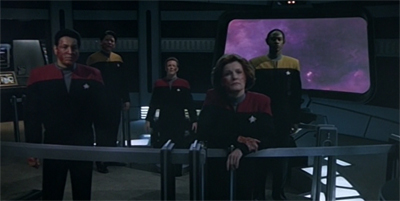
Dead to the world.
There is a palpable anxiety about mankind’s relationship to spaces that have been consciously designed and developed. There is considerable debate about whether those (usually urban) spaces exist to serve people or technology. After all, running on hard surfaces like roads and pavements takes its toll on the human body. It has been argued that cities like Jakarta are designed for machines like cars rather than for people.
This was a matter of considerable public interest during the eighties and nineties. The Congress for the New Urbanism was formed in 1993 to give expression to these concerns, and has been described as “the most important phenomenon to emerge in American architecture in the post-Cold War era.” In particular, new urbanism was seen as a rejection of the influence of industrialisation (and particularly the development of the automobile) upon urban planning following the Second World War.

Out of darkness.
One plays into that idea, with Seven’s increasingly fractured mental state reflected in the state of the ship around her. The title suggests that the episode is about Seven of Nine coming to terms with her individuality, but it also alludes to the idea that Seven and Voyager are becoming a single co-dependent entity. Seven’s paranoia and uncertainty reflects itself in the hallucinations that wander the ship corridors, in the colour shifts, and in the ghostly voices coming over the comm-line.
One turns Voyager into a haunted house, but one reflecting Seven of Nine. It is telling that Seven’s mental deterioration coincides with the breakdown of ship functions. The health of Seven and the health of Voyager are tied to one another, to the point that Seven ultimately has to choose to sacrifice life support in order to get the ship out of the nebula and prevent it from falling apart. At the climax of the episode, it seems that the only way to keep Voyager going is to sacrifice the only organic crewmember on board.

Droning on.
Seven of Nine is the perfect character for this story in a number of different ways. The fourth season of Voyager has repeatedly anchored the Borg in some primitive fear about mechanisation and redundancy, treating the Borg as a shadow that have stalked humanity from the renaissance into the distant future. After all, episodes like Scorpion, Part I, The Raven and The Omega Directive create a strong thematic link between the Borg as a concept and the workshop of Leonardo da Vinci.
Much like The Omega Directive, this episode uses the character of Seven of Nine to play on this notion of the Borg as an industrialised nightmare. It is a very clever way of writing what is essentially “a Borg episode” without having to draw the Borg Collective into the story. Seven of Nine becomes a prism through which these ideas might be explored without having to tell the sort of epic “event” story that is expected whenever the Borg actually show up.

Flickering sanity.
In particular, One feels like a logical and organic story for Seven of Nine. It is an episode that builds on the tension outlined in The Gift, the idea of a Borg drone who is forced to confront their own individuality as distinct from a group. What must it be like for Seven of Nine to exist as her own person? She has spent a year living apart from the Borg Collective, but in the company of the larger crew. What if Seven were really alone? What if Seven had nobody for company?
Janeway lays out the stakes early in the episode. “After being in the Collective, it wasn’t easy for you to adjust to a ship with only a hundred and fifty people on it, was it, Seven?” Janeway asks. “How would you feel with only the Doctor for company?” She elaborates, “Most humans don’t react particularly well to long periods of isolation. Borg Drones have even more difficulty.” It is a great storytelling hook, and one that feels like a nice story to tell at the end of Seven of Nine’s first season on the show.
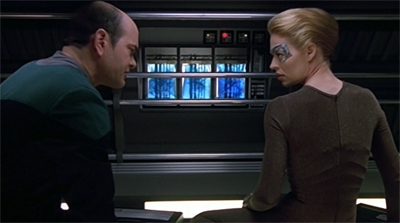
They just don’t gel.
Voyager had difficulty pacing Seven’s character development, mapping her plot out. After all, Seven of Nine looked practically human by the end of The Gift and was actively contributing to crew’s journey home by Day of Honour. She formally took charge of astrometrics in Year of Hell, Part I. That is a phenomenal amount of ground to cover in such a short time. Annika Hansen was assimilated at the age of six, and this is her first time since interacting with human beings as an individual. The fourth season of Voyager really rushes that arc.
However, One feels like it arrives at the right point in the season for Seven of Nine. It provides a nice bookend to The Gift, which had been the second episode of the season and found Seven of Nine accepting her place on the crew after being cut off from the Collective. One provides a nice funhouse mirror of that character beat, with Seven of Nine becoming more aware (and perhaps appreciative) of her bond to the crew after being cut off from them.

An empty vessel.
Like Demon before it, One is also a bottle episode. In order to help manage the production budget, and to pay for the more lavish and expensive episodes earlier in the season, Demon and One were both designed to save money. Both episodes are shot on standing sets with small casts, built around high concepts rather than spectacle. One only has two credited guest stars, both of whom have relatively small roles; Wade Wilson only appears in the second half of the episode, while Ron Ostrow appears in a single sequence as a Borg drone.
Whereas Demon struggled with these constraints, One excels. The use of standing sets plays up the claustrophobia of the episode. The corridors appear empty without the extras walking up and down. The more unsettling effects in One are decidedly cost effective. There is something surprisingly uncomfortable about seeing the familiar Voyager sets glowing the same green as the inside of a Borg Cube.

Sharing a drink she calls loneliness…
As Kenneth Biller explained to Cinefantastique, the episode lives or dies based on Jeri Ryan’s performance and the direction of the episode:
Jeri Ryan was great to work with. It was basically her, all day, every day, for seven days, grueling hours. She was very present and very there the whole time. This was a very difficult show emotionally for her where she has to slowly come unraveled. There were moments when we had to make a decision about exactly how vulnerable she was going to be and how much fear she would show. There were times when maybe she wanted to go a little further than I did, and I would have to remind her that we still have to give ourselves someplace to go, so that you don’t reach your most unraveled state until the end of the picture. There are significant portions of the episode that don’t really have any dialogue, which is always fun for a director, because you try to tell the story through the pictures. That was really a challenge.
One works remarkably well for such a high concept episode, particularly when contrasted with Demon.

One love.
At the same time, there are some minor issues with the script. Most obviously, One is far too willing to dismiss Seven’s hallucinations as the result of some interstellar phenomenon. One would be a much more interesting script if the episode left some ambiguity lingering as to whether Seven of Nine had really been driven insane by the isolation or whether her hallucinations could be explained away by “subnucleonic radiation.” Having the EMH explicitly explain that her hallucinations are due to the nebula takes away from the emotional power of the episode.
(To a certain extent, this reflects one of the more divisive storytelling choices in The Shining. Stanley Kubrick’s film is generally fairly ambiguous as to whether the hotel is really haunted or whether Jack Torrence has simply gone insane. However, there is one scene in which the ghosts haunting the hotel release Jack from the pantry, which would suggest that they are real and that Jack is perhaps being manipulated by some external force. At the same time, there is considerable debate over the scene. It has even been suggested Jack might have unlocked the door himself.)
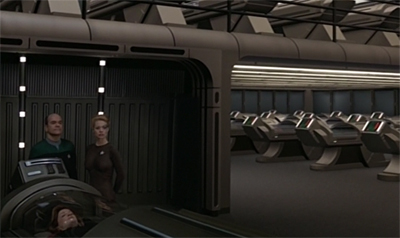
Pod people.
There is also a sense that One struggles with the guest character of Trajis Lo-Tarik, the creepy alien trader who encounters Voyager around half-way through the episode. The script is somewhat ambiguous as to how much of Seven’s experience with Lo-Tarik actually happened; presumably Seven procured the liquid helium somehow, but there are any number of very conscious inconsistencies in the dialogue exchanged during that scene.
Early in the conversation, Seven mentions the Borg. Lo-Tarik responds that he has “never heard of them.” However, later in that same scene, he reflects, “I’ve heard that drones can’t stand being alone. They’re too used to the Collective.” Lo-Tarik is quite pointedly rephrasing Janeway’s own uncertainty about Seven from earlier in the episode, suggesting that Seven is hallucinating and that Lo-Tarik has been replaced by a figment of her subconscious. It is a clever and uncanny touch. However, things quickly escalate.

Drone warfare.
Much of the penultimate act is spent in a battle of wills between Seven of Nine and Trajis Lo-Tarik, as Seven of Nine imagines the trader sabotaging the ship. The two banter over the comm line for the better part of the act, before Seven cleverly outwits him. However, only then does she realise that Lo-Tarik is a hallucination and that she has been chasing a spectre across the length and breadth of Voyager. It is a plot beat that doesn’t work for any number of reasons, most obviously because any shrewd viewer will deduce that Lo-Tarik is a hallucination very early in the sequence.
This battle of wits feels like a cynical plot beat designed to provide a more conventional dramatic tension by providing a clear antagonist and placing the ship in very immediate danger. For that entire act, it seems like One has lost faith in its audience, that the episode is worried that viewers would be unable to invest in a much more ambiguous psychological thriller. The initial fight between Seven and Lo-Tarik feels like pandering, something that belongs in a much more conventional episode, the stock “take back the ship” action beat of Displaced or Waking Moments.

Corrupted core.
This conventional action beat is very much a fixture of Jeri Taylor’s approach to scripting Voyager. As a producer, Taylor was very conservative and seemed uncomfortable with the idea of an episode of Voyager that did not feature a standard action beat. Resolutions might be a quiet romance involving Janeway and Chakotay, but it still has a big Vidiian battle. Coda might be a meditation on mortality, but it still features hallucinatory Vidiians. Real Life might focus on the EMH’s holographic family, but it still has an “anomaly of the week” plot.
There is also some of the awkward “non-conflict conflict” dialogue that defines a lot of Jeri Taylor’s work on Voyager, with characters talking about how they disagree with one another in a very detached and academic manner without actually investing in the debate. There is something very professional about how characters disagree with one another in Jeri Taylor scripts, a sense that emotion never actually clouds the issue; consider the crew standing up to Tuvok in Resolutions or the joy of the talent night in Coda.

Capping it all off.
Here, Chakotay expresses some legitimate concerns about assigning this responsibility to Seven of Nine. It’s a very reasonable topic to broach, particularly given that Seven is still relatively inexperienced and has made any number of questionable decisions in episodes like Prey and Retrospect. Chakotay’s worries are valid. “I know your bond with Seven is unique, different from everyone else’s,” he states. “From the beginning, you’ve seen things in her that no one else could. But maybe you could help me understand some of those things.”
Janeway shrugs off the question. “I don’t know if I can,” she explains. “It’s just instinct. There’s something inside me that says she can be redeemed. In spite of her insolent attitude, I honestly believe she wants to do well by us.” Chakotay responds, “That’s good enough for me.” It is a very weird scene, with Chakotay bringing up a reasonable issue with Janeway’s plan, only to accept the most paper-thin justification. There is no passion, no energy, no sense that Chakotay is really that bothered by any of this.

Collective concerns.
It is a marked contrast with the more effective and emotive scenes that the two characters share in episodes like Scorpion, Part I and Equinox, Part II. This is not simply conflict for the sake of conflict, it is accepting that two characters can hold two differing opinions. Deep Space Nine does this all the time, most notably with Sisko and Bashir butting heads in episodes like Battle Lines or In the Pale Moonlight. Their relationship is never particularly strained, and their conduct is never unprofessional, but the series acknowledges that the two characters have differing perspectives.
Still, these are relatively minor issues with One. For the most part, the episode is a clever character-driven claustrophobic thriller anchored in an interesting premise and powerhouse central performance.
Filed under: Voyager | Tagged: anxiety, automation, borg, fear, horror, jeri ryan, loneliness, star trek: voyager, the shining, voyager |




















Give it up for J. Paul Boehmer, who is always memorable in big roles or small. He’s got a great face, too. (Funny, since he wore makeup a lot of the time.)
Oops, sorry wrong episode. I take it back, this one sucked.
I didn’t think it sucked. Clumsy “action act!” and “overburdened technobabble explanation” aside, I actually quite liked it.
I like this episode and I like Seven of Nine and I think Jeri Ryan is gorgeous and ridiculously talented.
That said the more I learn about the problems behind the scenes and the very understandable frustrations of the long term actors in the series and honestly it starts to give the show a bit of a bitter taste for me. Objectively we have a character and actress who hijacked a series; just because I like both doesn’t change that.
Yeah, the production history of Voyager really sours the show. I think the trouble behind the scenes on the second season really turned me off the series, to be honest. Producers and writers sniping at each other in the fan press, trying to cut each other off at the news rather than trying to make a good show.
But I find it hard to begrudge the focus on Ryan too much. I think many of the creative decisions made – pushing her so much to the fore, putting her in those costumes, rushing her development – were ill-judged and cynical, but I also think that Ryan greatly improved Voyager by her presence. She is a phenomenal performer. And as much as “the Seven Show” shortchanged the other cast members, it at least provided a direction that had been sorely lacking from the show to that point.
I do like Ryan a lot, but I can’t help but remember this was literally the second show she ‘stole’ – she was in ‘Dark Skies’ as a Soviet femme fatale with a heart of gold immediately before joining ‘Voyager’ and basically pushed the original female lead out of the picture.
(Also you really must review ‘Dark Skies’ at some point. Given everything you’ve said about the 90s and the 60s I’d be absolutely fascinated to see what you make of it.)
Dark Skies is on the (ever increasing) watch list.
I’m very glad for the addition of Seven to the cast. I like Janeway and Tuvok and The Doctor, but I’d be happy to never see Harry Kim, Tom Paris, or Neelix again. Seven didn’t come into an excellent show and take over from fascinating characters who were doing a great job; she came into a so-so show that needed a more interesting character, because many of the ones they already had were bland and dull.
I wish they’d developed Tim Russ’ Tuvok more, and I think B’Elanna could have been explored more, but I’d have been perfectly happy if Kim and Paris had expired in their search for deuterium in “Demon.” 🙂
Yep, this is the paradox of Seven’s arrival. She didn’t muscle out interesting characters so much as take away oxygen for characters that the writers weren’t interested in anyway.
This was indeed like a huge metaphor for the show, with Seven literally replacing the entire crew.
Much of my problem with how Seven consumed Voyager, is also tainted by the fact that she dated Braga. Talk about a conflict of interest. He creates a borg character, casts her as a blond with Baywatch-level looks, and then proceeds to date the actress he casted off-set, which still writing her in as the plot-leader.
It’s insane that there wasn’t a mass insurrection from the other actors. Braga seemed to see himself as Roddenberry 2.0, since the legends of Roddenberry dating Nichelle Nichols are fairly well known at this point.
Loved this episode. My interpretation is that the hallucinations Seven experiences are still driven by her insecurities, fear, and anxieties. As such the cat and mouse plot still works quite well for me, because even though we know it isn’t real, it’s amazing how revelatory it is. I love the way this episode juxtaposes Seven’s increasing lack of composure with the projection of her inner demons. In general, Seven always places a great deal of importance on her sense of (slightly condescending) cool, though Jeri Ryan never loses the emotionality of the character. We can always see her process emotions which, as someone new to the idea of emotionality in general, we can understand is causing quite an internal storm. Seeing her endeavor to keep that cool even as her inner worries are projected outward with little modesty is fascinating. It really gets to the heart of the character.
Interesting the writers compared One with The Shining, because I would say the better comparison is Roman Polanski’s film Repulsion, making it an interesting bookend with the other horror episode at the beginning of the season. The psycho-sexual element is significantly toned down from Polanski’s film, but it’s Star Trek so that makes sense.
Kenneth Biller’s directorial work is amazing. Perhaps he should have focused more on being an authorial visual voice for the show rather than writing.
I also would push back against the idea Jeri Ryan hijacked this show. She was hired to do a job, and she did that job well. Anyone would want to write for an actor of this caliber, and given the mediocrity of the first three seasons it’s easy to see why the writers rallied around her. The character is a jolt of lightning. Perhaps Jeri Ryan should endeavor to be less talented in the future.